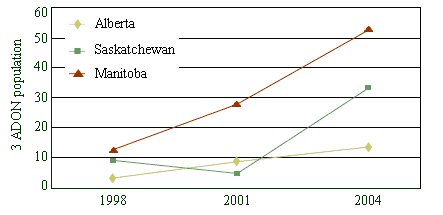This page is archived. We will no longer be updating the information, but it can be used for research or reference purposes.
Changes To Fusarium Tolerances In Western Canadian Wheat Classes
Fusarium graminearum, the most important fungus causing the fusarium head blight (FHB) disease in cereals, has been undergoing an important population shift. A new population of toxin-type or chemotype is replacing the old chemotype; and this has major implications on the industry. The shifting population dynamics has prompted the Canadian Grain Commission to reduce the tolerance for % Fusarium diseased kernels (FDK) in wheat.
Why The Lower Tolerances?
Based on ongoing monitoring, evaluation and research conducted at the Canadian Grain Commission, it was determined that previous FDK tolerances were no longer able to accurately predict the average level of deoxynivalenol (DON). This has led to fusarium tolerances being changed in various wheat classes.
Fusarium graminearum can be broadly divided into two toxin types or chemotypes based on the production of the 8-ketotrichothecenes mycotoxins, deoxynivalenol (DON) and nivalenol (NIV). DON-producing isolates can be further distinguished on the basis of the predominant acetyl DON derivative that they produce: 3-acetyl DON (3-AcDON) or 15-acetyl DON (15-AcDON). Over the years, with the shift in the chemotype population dynamics to the 3Ac-DON chemotype, the relationship between fusarium damage and DON has changed.
Until recently, the 15Ac-DON chemotype - was the major cause of FHB in Canada. The discovery of a second chemotype 3Ac-DON came about through joint efforts by Canadian and US researchers. The 3Ac-DON chemotype is established in Europe and South America and it is speculated that may have moved from there to North America. Analyses by researchers, of FHB pathogen diversity, revealed that 3Ac-DON producing Fusarium graminearum are now widely prevalent in North America and there is significant population shift in FHB pathogen composition. The 3Ac-DON chemotype frequency in western Canada has increased more than 14-fold between 1998 and 2004. On average, isolates from 3Ac-DON populations produced significantly more trichothecene mycotoxins and has a significantly higher capability of spore production and growth rates than isolates from the 15Ac-DON population. The aggressive 3Ac-DON chemotypes appear to have an advantage over the older chemotype, and selection is driving the rapid spread of an introduced pathogen population that is more toxigenic and potentially more vigorous. The new chemotype produces more DON toxin based on the % of Fusarium diseased kernels. The older chemotype was known to produce roughly 1% of DON toxin for every 1% FDK; however, the newer 3Ac-DON chemotype produces higher levels of DON for every % FDK.
The analysis of Canadian Grain Commission’s collection of Fusarium graminearum shows two patterns in the occurrence of the 3Ac-DON chemotype, one in the east and the other in the west. In eastern Canada, Prince Edward Island currently has the highest proportion, with nearly all isolates being 3Ac-DON. As you move west, the proportion of 3Ac-DON gradually declines, until Ontario where less than 10 percent of isolates are 3Ac-DON. In western Canada, the percentage of 3Ac-DON is highest in Manitoba, where nearly half of the isolates are 3Ac-DON.
3Ac-DON Population Shift

Source: Chemotype changes in the Fusarium graminearum population in Canada. Canada Grains Commission: http://www.grainscanada.gc.ca/str-rst/fusarium/cc-cc-eng.htm
What Does This Mean For Manitoba Farmers?
The discovery of this previously unrecognized pathogen diversity and shift towards more aggressive chemotype 3Ac-DON has significant implications for food safety and cereal production in Canada. For Manitoba farmers, they should continue to use multiple management strategies to mitigate the risks of fusarium head blight. Although FHB infection is highly influenced by environment, strategies such as crop rotation, variety selection, ensuring good crop establishment, increased seeding rate to reduce tillering and chemical (fungicide) can play a role in minimizing the impact of FHB in years where disease pressure is not overwhelming.

